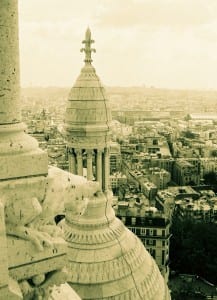Montmatre and painter Maurice Utrillo
Montmatre and painter Maurice Utrillo
Montmatre and painter Maurice Utrillo
-
Hannah
-
Hannah
There is something inherently inspirational about the Montmatre in Paris, which gives its name to the surrounding district. On a clear, sunny day, climb the many steps to the white-domed Basilica of the Sacré Cœur at the summit, sit with a baguette de jambon et fromage (cheese and ham baguette) and gaze out over the rooftops of Paris. Drink in the history all around – here, in the church of Saint Pierre de Montmartre, the Jesuit order of priests was founded; here Henry IV’s artillery rained down fire on the city during the French Wars of Religion of 1562–98.
But what you will no doubt most associate with this place is liberté – here, at the end of the nineteenth century, outside of the Paris city limits, alcohol flowed and cabaret, such as that at the Moulin Rouge and Cabaret au Lapin Agile (Nimble Rabbit Cabaret) boomed. No wonder artists flocked to the area for its bohemian atmosphere and wonderful vantage point over the city atop the hill – from Salvador Dalí to Amedeo Modigliani, Claude Monet to Piet Mondrian, Henri Matisse to Pierre-Auguste Renoir, Pablo Picasso to Vincent van Gogh, Henri de Toulouse-Lautrec to my personal favourite, Maurice Utrillo.
Unlike many of the artists who were inspired by the area, Utrillo (1883–1955) was born in Montmatre, and his works embody the colour and vibrancy and artistic sensitivity of the place. Utrillo’s mother was a circus acrobat turned self-taught painter who had learnt her craft posing for artists like Renoir and Toulouse-Lautrec, and then from her mentor, Degas. It is unclear who his father is, but the following appears in an article in the New York Times.
After Maurice was born illegitimately to Suzanne Valadon, she went to Renoir, for whom she had modeled nine months previously. Renoir looked at the baby and said, “He can’t be mine, the color is terrible!” Next she went to Degas, for whom she had also modeled. He said, “He can’t be mine, the form is terrible!” At a cafe, Valadon saw an artist she knew named Utrillo, to whom she spilled her woes. The man told her to call the baby Utrillo: “I would be glad to put my name to the work of either Renoir or Degas!”
With such an artistic heritage, it is little wonder Utrillo was so talented. Sadly, he grew to be a man plagued by mental illness and was a regular occupant of the mental asylum. Still, he was recognised in his lifetime for his artistic achievements, and was awarded the National Order of the Legion of Honour before his death.
If you get the chance to visit Montmatre, do make time to pop into the Musée de Montmartre. The building is where Utrillo lived and worked in a second-floor studio.
To view some Utrillo paintings, I recommend visiting http://www.utrilloexperts.com/gallery.php.
